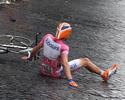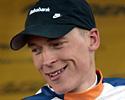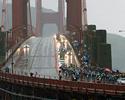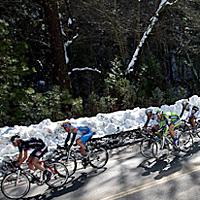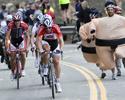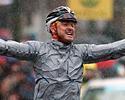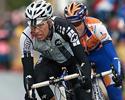
Recently on Cyclingnews.com |
Tour of California News, February 24, 2009Edited by Daniel Benson, Bjorn Haake & Peter Hymas Tour of California wrap-upBy Kirsten Robbins in Escondido, California
After eight gruelling stages, pre-race favourite Levi Leipheimer won his third consecutive Tour of California, but unlike his previous triumphs, this was a victory like no other. The Santa Rosa native and his Astana team went up against longer stages, more climbing, foul weather, crashes and most importantly a higher calibre of competition. Leipheimer took the golden leader's jersey after the stage two finish in Santa Cruz and claimed the overall win would come down to his stage six time trial performance. "A lot depended on those thirty minutes in Solvang," he said. "Those thirty minutes and the fact that I had the best team. We really did have the best team." Leipheimer's winning time of 30:39 was fast enough to secure the stage victory over US National Time Trial Champion, David Zabriskie (Garmin-Slipstream). Zabriskie secured second place and Michael Rogers (Columbia-Highroad) rounded off the podium. There were no changes to the leading trio in the stages that followed. Behind them in the overall classification the bad weather was starting to play a factor, ruling out many of the other pre-race favourites through sickness, crashes and a lack of form. It made for exciting racing, with riders like Landis, Hamilton and Schleck in positions of having nothing left but to push for stage wins, jersey points and the chance to crack Johan Bruyneel's men. "He has a certain goal in the season and this was one of them," Bruyneel said of Leipheimer. "He's the kind of guy that when he really knows he is in a position to lead, everyone on the team really trusts that he is going to be ready. We saw it he was ready physically and in the wind tunnel to fine tune himself. Everyone saw that he was focused on the team goal. A leader has to show to the team he is ready because the guys have to suffer for him and they needed to know he will deliver. To do this three times in a row is not easy and there was a lot of pressure on him." The Jerseys
Mark Cavendish (Columbia-Highroad) convincingly won the event's Best Sprinter competition after his back-to-back victories in stages and five. "It was pretty tough riding over those climbs," Cavendish said. "That part was always going to be hard because they added the last stage that kept the overall up in the air all the way to the end." Jason McCartney (Saxo Bank) moved into the KOM lead after the previous leader, Francisco Mancebo (Rock Racing) crashed on the penultimate stage. McCartney went into the eighth and final stage with a goal of picking up more points toward the jersey victory. "I think it was very unfortunate that Mancebo crashed yesterday," McCartney said. "I really wanted to honour the jersey and try to work at getting my team on the podium with it." Robert Gesink (Rabobank) took home his third consecutive Best Young Rider Jersey but the Dutchman admitted that the jersey was not his primary goal. "I wanted to go for stage wins here," he said. "I am very happy to have the young rider jersey but I also think I was in good condition and could try to do something more." The course
According to Andrew Messick, President of AEG Sports, he tried to design a course that would challenge Leipheimer's winning streak. Though Leipheimer shone, the course design was a success in mimicking a true European-style tour. "We are looking forward to designing the 2010 course," Messick said. "We were treated to a race that felt like Europe, with a world-class international peloton. Cycling needs to have great races outside of Europe and it felt like that this week." The final climb over Palomar Mountain was successful in bringing a European feel to North American bike racing. The 'queen' stage was held on the final day holding suspense in the race until the very end. "The speeds we went up Palomar and with the riders we had, I had to remind myself it was February in California and not July in the Alps." Messick was satisfied with the new courses designs which included several new features. "We were optimistic a year ago with the course we wanted and how we wanted it to unfold," Messick said. "We never went to San Diego, the Sierras or Santa Cruz. Looking back those three stages were remarkable. There was epic racing and beautiful terrain and people are paying attention to what we are trying to accomplish. When you look up and down at the teams who were here they were loaded. There was a lot of pressure on Astana and Levi and on every turn they answered and it was amazing to watch." Tour of California in the frameBy Daniel Benson
There's no doubt that this year's Tour of California was a huge success. From the Olympic champion storming to the first leader's jersey in Sacramento to Levi Leipheimer claiming his third consecutive overall win; we've seen some of the most thrilling racing on American soil in years. And it's been a big week too, with an estimated two million fans flocking to the roadsides for America's biggest cycling race. Of course we were in for a show right from the get-go, with a start list jam-packed with enough glitz and glamour to give the Academy Awards a run for its money. Armstrong, Leipheimer, Sastre, Landis, Basso, the Schlecks, Cavendish and Boonen made up the finest cast the race had ever seen. There was an improved route, too. We saw the peloton face climb after climb – albeit mainly in the middle of stages – but with so many riders brushing away their winter cobwebs, it was gripping viewing as to who could last the pace. Many couldn't, but it only helped build the suspense. First Sastre and Landis dropped out of the running, while surprise-package Mancebo made use of the bad conditions and lack of radio communications to ride to an old-school style win. There were more surprises just around the corner when a fresh-faced Thomas Peterson took stage two, while Leipheimer played his cards early, but to perfection, with what turned out to be the race-winning attack. There was room for the sprinters to showcase their talents as well. Cavendish and Boonen raced last month at the Tour Qatar, but this was different – the world was now watching as the Manxman stole the show with back-to-back wins. If there was ever any doubt as to who the fastest rider in the world is, it's surely been dispelled now. We also had a race-deciding time trial, and while the race provided little in the way of shocks there after, everyone was still tuning in to see if Astana could handle the pressure and attacks unleashed on them, as first Rinaldo Nocentini, and then Fränk Schleck won from breakaways. As the curtain falls on the fourth edition of the race, we've put together this highlights package of images. It's been a great race and it's been even greater having you with us. Enjoy! Continue to the complete photo feature Palomar – The smaller Alp d'Huez of AmericaBy Kirsten Robbins in Escondido, California
The return of Lance Armstrong could be responsible for the huge crowds that have greeted the riders over the course of the week, but also factoring in is the first visit of the Tour of California to San Diego County, a hotbed for cycling. Hundreds of fans began camping on the top of Mount Palomar days in advance, and by the time the race rolled through there were thousands at the top. The decisive climb was located mid-stage and resembled that of a narrow European ascent, less for its length or gradient and more because of the notorious mountain contenders that pushed their way through the screaming crowds either side as they weaved up to reach the top. Overall winner Levi Leipheimer looked around and saw the faces of his own teammate Lance Armstrong, Fränk and Andy Schleck, Michael Rogers, Robert Gesink, David Zabriskie and Vincenzo Nibali. If the 2008 Tour de France winner, Carlos Sastre and the former Giro d' Italia winner Ivan Basso had not abandoned the race due to injuries, it would have had even more of a Grand Tour feeling. "With the speed we climbed and with the riders we were surrounded by in the last kilometres, I had to remind myself it was February in California and not July in the Alps," said Leipheimer. Zabriskie was impressed with the number of fans, but was a bit skeptical as to how well under control the crowds were. "The crowds were impressive, but were kind of tripping over each other at the top. I had to keep my head up. They are used to it in Europe and get out of the way, but I wasn't sure here. But I had a great time and it was nice to have them all over the course cheering." Palomar Mountain climbed nearly 20 kilometres and up to 5,123 feet, with a seven percent average grade, 4,200 feet of climbing and 21 switchbacks. According to Armstrong the climb was "legit." "It was very similar to a European climb, steady and consistent," Armstrong said. "There are not a lot of climbs in the USA that are like that. It was very, very hard. Plus, it's not exactly right down the street from everybody's house. Its pretty remote up there, I heard stories of people camping out last night. It's very, very European – it's amazing." Sastre abandons but remains positiveCarlos Sastre did not start the final stage of the Tour of California, after suffering with sickness throughout the race. However he drew a positive perspective on his first race of the season. "Eight days of competition were enough, so I decided to not start today," Sastre said. After flu, Sastre now finds himself battling sinusitis. To make things worse he suffered from a crash, "from which I haven't recovered fully yet." Sastre is now looking forward to some rest before returning to his native Spain. "Sunday I fly back and I hope to be home Monday night." Sastre wants to use the form he developed in California to get some quality workouts in before the Vuelta a Castilla a León. "I hope to be in better form then." American-Continental team success in the Tour of CaliforniaBy Kirsten Robbins in Escondido, California
Four years ago the Tour of California was designed as a platform to raise the bar in American racing. This year continental American-based teams invited to compete in the nine-stage event faired well against a world-class peloton nick-named a 'mini' Tour de France. Rock Racing wowed the cycling world when Spaniard Francisco Mancebo took stage one and the most important win in the team's history. He went on to take a commanding lead in the King of the Mountain competition and the team continued to represent most of the event's decisive breakaways. Unfortunately Mancebo crashed on the stage seven descent to the Rose Bowl and was sidelined with a broken thumb and a concussion. Despite the heavy blow Rudy Pevenage said he was pleased with his squad's overall success. "I think we had a very good race this week," Pevenage said. "I think after Astana we had the second best team because we were involved in the race, in all the breakaways, in the jersey competitions and in the stage finishes. Being on the podium with a jersey would have been great but honestly, I could never have expected anything better from his team this week." Team's OUCH presented by Maxxis, BMC and Team Type 1 also made a strong presence in the daily breakaways. In particular, Jeff Louder (BMC), Cameron Evans and Rory Sutherland (OUCH), Valeriy Kobzarenko (Team Type 1) spent more than 350 kilometres off the front of the peloton. According to Louder, his squad hoped to be more involved in the stage finishes but a stage one set back forced them to revert to plan-B and going for long breaks. "We came into the season wanting to be there in the finales because last year we had a strong philosophy of being very aggressive," said Louder who lost more than 15 minutes at the end of stage one due to treacherous weather conditions.
"It was a little bit of a disappointment that the first few days didn't go according to plan but we know this is a very big race and it was important for us to show ourselves as much as we could. Losing time freed me up for the rest of the race. I liked having that freedom. I spent at least 350-kilometres up the road." Colavita-Sutter Home was ranked second in the previous year's NRC standings and brought a team to contest the three sprint stages. Its Argentinean sprinter Lucas Sebastian Haedo proved to be a formidable contender amongst the sprint heavy peloton placing with in the top ten placings in stages three, four and five. "I would have liked to be on the podium here and I was close a few times," said Haedo. "The best sprinters in the world were here and it was a very good experience for me to go up against them." Sebastian Alexandre, directeur sportif, commended Haedo's teammates for delivering him to a position of contention in the finale of each sprint. "We knew the first few teams were going to be very hard and we need to be conservative so that we had fresh riders for the sprint stages," Alexandre said. "We know that Seba is one of the fastest guys racing in America and we had a better chance to be in a podium position with him because of the fitness he has right now." Team Bissell set the stage by placing five riders within the top 20 of the opening prologue. Time trial specialists Tom Zirbel, Jeremy Vennel and Ben Jacques-Maynes went on to impressive performances in stage six's 24-kilometre time trial held in Solvang. Jacques-Maynes also represented two significant breakaways in stages two and eight. "I think we showed ourselves well in the time trial," said Glen Mitchell, directeur sportif. "We hoped to have a top five placing in the prologue but we are certainly pleased with both the prologue and the time trial. Having a core group of riders in the top end of the time trials was something that we expected." Jelly Belly's break away rider Matt Crane brought his team some lime light when he earned the event's Most Courageous Rider jersey during stage five in Paso Robles. Crane was a member of a six-man break away that gained more than six minutes on the peloton. "I've been looking forward to this race for a long time and to come out and represent Jelly Belly was huge," said Crane. "Its what I've been training for. When you have the best in the world racing a long side you its very special moment to be presented a jersey on stage." (All rights reserved/Copyright Future Publishing (Overseas) Limited 2009) |
